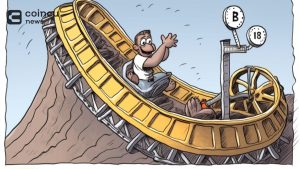Even the most seasoned veterans can escape the volatility of the crypto market as every bull and bear market shares similarities with previous cycles. However, it still has the potential to move in an unexpected direction and wipe out the fortunes of aspiring crypto millionaires.
Typically, in 2021, the market completely deviates from the $100,000 estimate predicted by crypto analysts and influencers.
Currently, bitcoin price is more than 50% away from ATH at $69,000 and altcoins are even worse as many tokens are down more than 60% in the last 2 months. At times like these, traders need to regroup and reassess their investment strategy, rather than simply buying every time the price falls.
Here are five strategies traders can use to weather the unexpected crypto winter and keep as many assets in their portfolios as possible.
Reduce exposure to highly volatile altcoins
When a widespread market downturn begins, the first step is to re-evaluate current positions and reduce exposure to the most volatile assets.
Usually these are new projects in the crypto market like Coin Meme, NFT or rebase projects like Wonderland (TIME) as many token holders are newcomers to the community and not homeowners.
$TIME to wrap it up. pic.twitter.com/hJI3jB6eU0
— humble defi farmer (@PaikCapital) January 25, 2022
Investors must first look at the project’s GitHub account to see the level of activity and the number of developers dedicated to creating the protocol.
If there’s little development despite the conspicuous hype and big promises, it could be one of those projects that investors might want to backtrack on when the market kicks in.
Traders can then invest these funds in staking stablecoins to profit or buy future market downturns.
Price averaging strategy
Price averaging (DCA) is a strategy investin which an investor regularly divides the total amount by transactions or by a specific price of a specific asset class in order to reduce the risk of the total amount of capital in which he invests.
While the DCA strategy is a good way to increase exposure to projects that are stable over time, it is best for traders to wait until the market settles somewhat and the accumulation phase begins.
The focus of the averaging strategy should be on projects with active development, an engaged community, and a clear roadmap outlining how the project intends to continue to grow and become profitable in the future.
Mark out
Staking is probably the easiest way to add value to a portfolio over the long term and take the pressure off of daily price fluctuations as the staked asset continues to accumulate tokens.
Most Layer 1 protocols offer the ability to monetize their native tokens on the network, including Solana, Cardano, Polygon, and Avalanche.
⚡️Top projects by total value invested
January 25, 2022$SOL $ADA $ETH $LUNA $AVAX $POINT $BNB $ATOM $ICP $NEAR $MATIC $FTM $XTZ $ALGO $CAKE pic.twitter.com/X9IgsonWKr— CryptoDep (@Crypto_Dep) January 25, 2022
Ether holders can also participate in staking their tokens on the beacon chain for Eth2, but it is important to note that staking rewards cannot be claimed until Eth2 is fully launched.
There are many other staking options on the network, from gaming protocols like Axie Infinity and Illuvium to NFT marketplaces like LooksRare, so once you’ve researched and engaged with the projects, all investors have to do is take a look.
Find projects with a growing ecosystem
Projects that help token holders make money through staking, liquidity, borrowing, and airdrops are also worth considering when the market turns negative.
Staking is the simplest form as the number of tokens will increase over time, but there are other options including token launchpads, NFT marketplaces and protocols that provide airdrops to community members.
An example of a protocol that rewards early adopters is Cosmos (ATOM). The growing project community is connected via the Interblockchain Communication Protocol (IBC).
ATOM founders and those who participated in the Osmosis Decentralized Exchange (OSMO) were rewarded by large number of Airdrops from projects started in the ecosystem, this is a way to increase activity in their community.
Invest in yourself
One of the most likely things an investor can do during a bear market is invest in themselves by learning something new.
This not only helps investors avoid sell-offs and lost profits in the future, but also enables them to remain strong and profitable in the market.
Despite the market slump, cryptocurrencies continue to evolve towards mass adoption and the number of jobs in the blockchain sector will continue to grow in the future.
Ultimately, whether it’s programming in Solidity, experimenting with digital and graphic design to create new NFTs, or just doing research to gain insights into different areas of the market, the key to surviving in a bear market lies there , stay positive patient and never stop learning something new.
Join CoinCu Telegram to keep track of news: https://t.me/coincunews




















